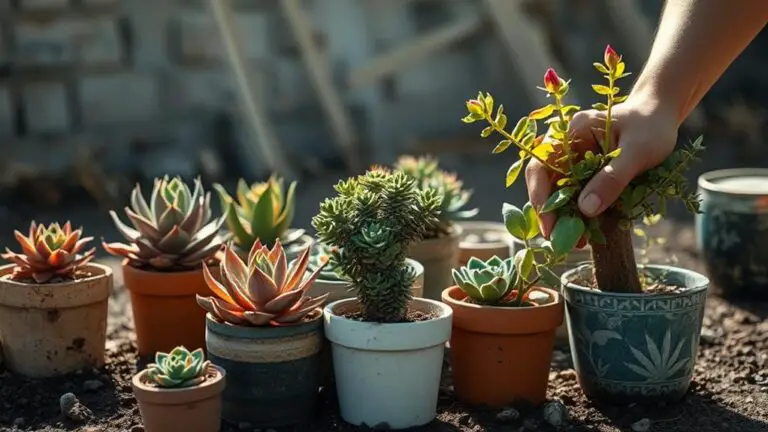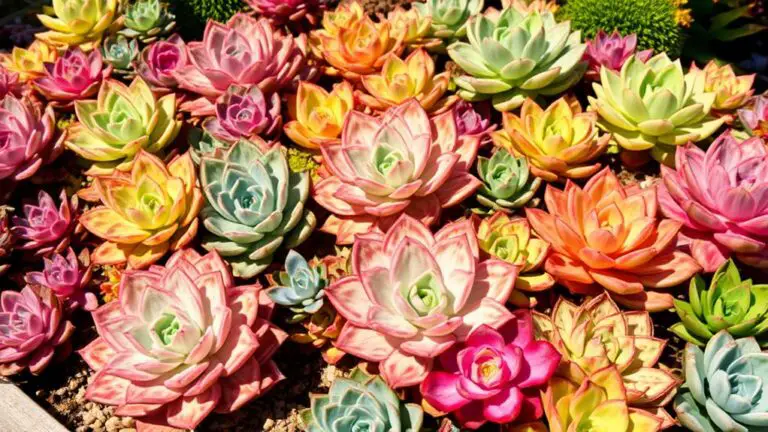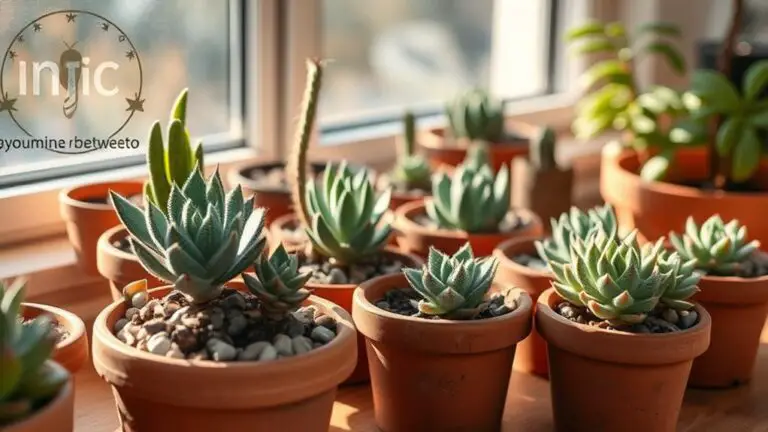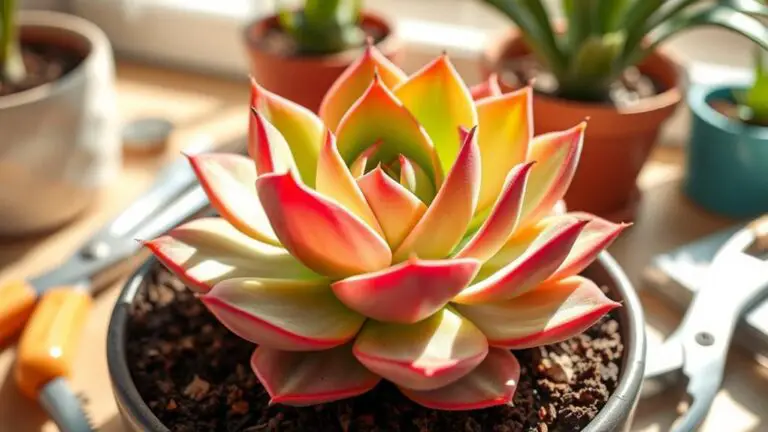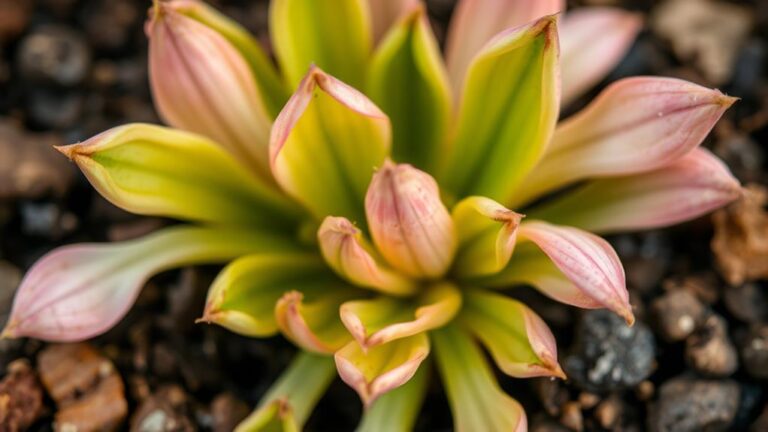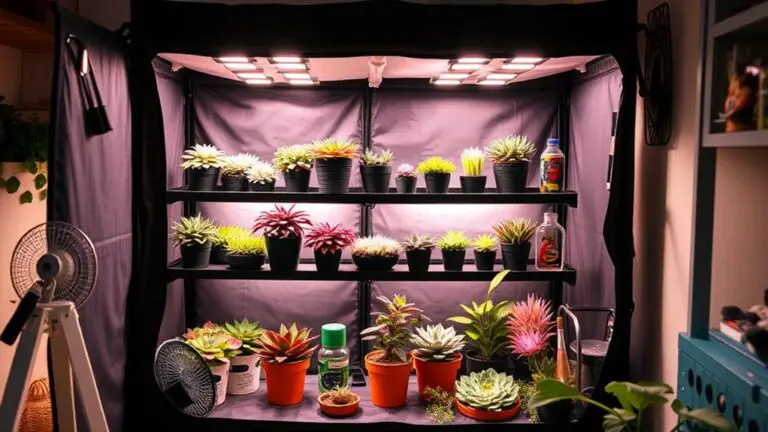Why Haworthia Zebra Is the Best Succulent for Beginners – A How-To Guide
If you're new to the world of succulents, the Haworthia Zebra stands out as an excellent starting point. Its striking appearance and minimal care requirements make it a favorite among beginners. You'll find it thrives in bright, indirect light and requires watering only every 1-2 weeks, making it a low-maintenance addition to your home. Furthermore, it's pet-friendly, so you won't have to worry about keeping it away from your furry friends. Curious about how to get the most out of this resilient plant? Let's explore its care needs and more.
Features of Haworthia Zebra
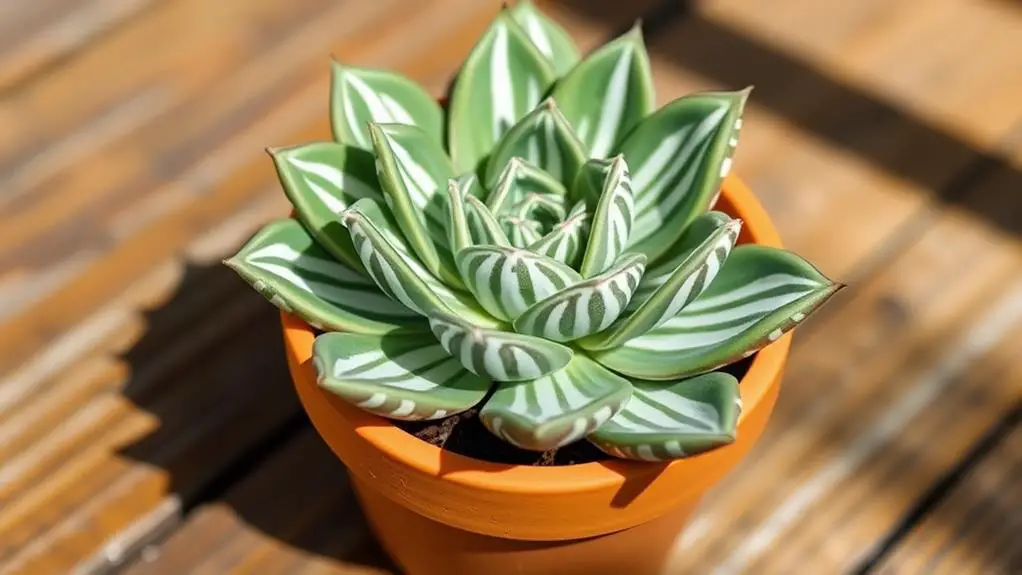
Haworthia Zebra's striking appearance makes it a standout choice for any plant enthusiast. This succulent, also known as Haworthia Fasciata, features thick, dark green leaves adorned with distinctive white tubercles that look like zebra stripes. Its unique pattern and compact size make it visually appealing for any plant collection.
One of the best things about the Haworthia Zebra is its low maintenance. As a beginner, you'll find this plant easy to care for. It thrives in bright, indirect sunlight but can also tolerate medium to low light conditions, making it versatile for various indoor environments.
You only need to water it sparingly, as it prefers well-draining soil to avoid root rot. Moreover, this succulent is non-toxic to pets, so you don't have to worry if you have cats or dogs at home.
The Haworthia Zebra is also a slow grower, so it won't outgrow its pot quickly, reducing the need for frequent repotting. While it rarely blooms indoors, when it does, it produces charming, tubular flowers that add a unique touch to its overall appearance.
With its striking looks and easy care, the Haworthia Zebra is perfect for beginners.
Lighting Needs
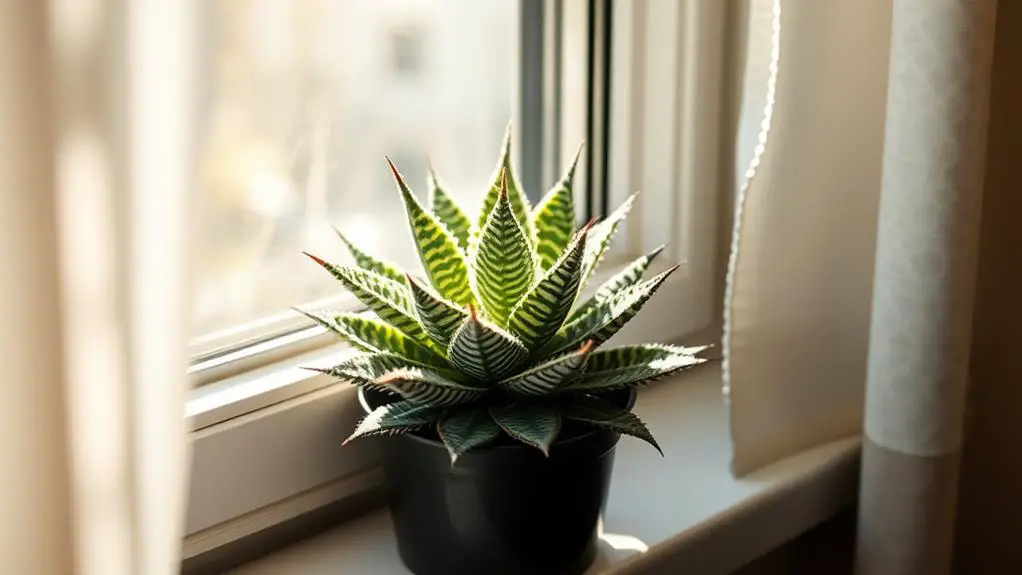
When it comes to lighting needs, the Zebra succulent thrives best in bright, indirect light, making it an ideal choice for indoor settings.
Haworthia Zebra plants love the light, but they prefer it filtered. Place your plant near a south or east-facing window where it can enjoy 4 to 6 hours of bright light each day. This will help enhance its vibrant red and orange pigments.
However, avoid direct sunlight, especially during hot afternoons, as it can lead to dry tips on the leaves. Direct sunlight exposure, particularly in the afternoon, can be too intense for these plants and might cause leaf scorch.
If you notice the tips of your Haworthia Zebra turning dry, it's a sign that the light might be too strong. In this case, providing some shade or moving your plant a bit farther from the window can help.
Even though Haworthia Zebra plants prefer bright light, they can tolerate medium and low light conditions. Just keep in mind that in lower light, their growth may slow down.
Following this care guide will help you manage their sunlight exposure effectively, ensuring your plant stays healthy and vibrant.
Watering Techniques

When it comes to watering your Haworthia Zebra, make sure to only water when the soil is completely dry, which is usually every 1-2 weeks.
Always use a pot with drainage holes to let excess water escape, preventing root rot.
Deep watering is key, so let the water flow out of the bottom of the pot for healthy roots.
Ideal Watering Frequency
To keep your Haworthia Zebra healthy and thriving, it's crucial to master the ideal watering frequency. Water your plant only when the soil is completely dry. Typically, this means watering every 1-2 weeks. Overwatering can lead to root rot, a common issue with succulents.
To check if your plant needs water, use the finger test. Simply insert your finger into the soil up to the first knuckle. If the top 1-2 inches of soil feel dry, it's time to water. Make sure you water generously until it drains from the bottom of the pot. Those drainage holes are there to help remove excess water, preventing it from sitting in a saucer and damaging the roots.
Avoid wetting the leaves while watering. This helps reduce the risk of rot. A squeeze bottle can direct the water straight to the soil, keeping the leaves dry.
Watch for signs of overwatering, such as mushy or discolored leaves. If you see brown leaf tips, you might be underwatering. Adjust your watering routine based on these signs to keep your Haworthia Zebra in top shape.
Proper Drainage Techniques
Maintaining the right watering frequency is only part of the equation; guaranteeing proper drainage is equally important for your Haworthia Zebra's health. Without proper drainage, water can accumulate, leading to root rot and other issues. Here are some key steps to guarantee your plant thrives:
- Choose the Right Pot: Guarantee your pot has drainage holes. This prevents water from pooling at the bottom, which can be disastrous for your Haworthia Zebra.
- Use a Well-Draining Mix: Opt for a cactus potting mix or make your own blend using pumice, perlite, and sand. This promotes ideal moisture control and prevents overwatering.
- Water Deeply and Discard Excess: Water your plant deeply until you see excess water draining from the bottom. Discard any water that collects in the saucer to avoid moisture buildup.
Allow the soil to dry completely between watering sessions, typically every 1-2 weeks, depending on environmental conditions.
Always monitor your plant for signs of overwatering, like mushy leaves or discoloration, and adjust your watering frequency accordingly.
Soil Requirements
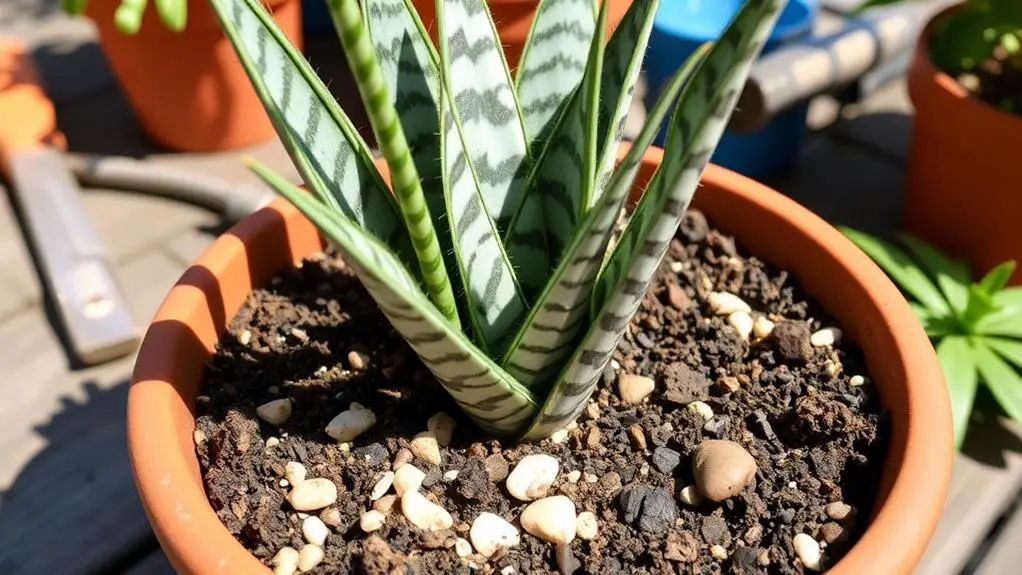
When it comes to soil, your Haworthia Zebra will flourish in a well-draining mix, like cactus potting soil or a combination of pumice, perlite, potting soil, and sand.
Make sure the soil pH is between 6.0 and 7.0 to support healthy growth.
Deep pots help with airflow and prevent root problems, so keep an eye on drainage to avoid root rot.
Ideal Soil Composition
For the Haworthia Zebra, an ideal soil composition is vital to guarantee its health and growth. This succulent houseplant thrives in a well-draining cactus potting mix, which prevents moisture retention and promotes healthy root growth.
To create the perfect mix, you'll need to use equal parts of pumice or perlite, potting soil, and sand. This combination guarantees the substrate is light and airy, which is essential for your plant's health.
Here are the key components for the ideal soil composition:
- Pumice or perlite – These materials keep the soil light and airy, preventing compacting.
- Potting soil – Provides essential nutrients while maintaining a balanced pH.
- Sand – Enhances drainage and prevents water retention, reducing the risk of root rot.
Using a deep pot is also recommended for Haworthia Zebra because it accommodates the plant's long root systems and enhances airflow around the roots.
The soil's pH should be slightly acidic to neutral, ideally between 6.0 to 7.0, supporting optimal growth. Always check the soil's drainage quality, as heavy soils like clay can lead to root rot.
Drainage Importance
To guarantee your Haworthia Zebra thrives, proper drainage is essential. This succulent loves well-draining soil, which helps prevent water retention and root rot. You can use a cactus potting mix or create your blend with potting soil, pumice, and sand. These ingredients make sure that water flows through the soil without getting trapped, keeping your plant healthy.
Understanding the drainage importance means recognizing that compacted soils can suffocate your Haworthia's roots. If the soil is too heavy, it won't allow air to reach the roots, leading to plant decline. That's why regularly checking soil drainage is critical. If you find the soil is too compacted, it's time for repotting.
Haworthia Zebra has long roots, so deep pots are recommended. These pots enhance airflow and prevent water from accumulating at the bottom, which is essential for avoiding root rot.
Also, repotting every couple of years with fresh soil guarantees your plant gets the nutrients it needs while maintaining proper drainage conditions.
Optimal Soil Ph**
Ensuring your Haworthia Zebra thrives starts with understanding its soil pH requirements. The ideal pH range is slightly acidic to neutral, between 6.0 to 7.0, for maximum nutrient absorption. This helps your plant grow strong and healthy.
Here are three key points to remember:
- Use a well-draining mix: A cactus potting mix is perfect because it lets air circulate around the roots, which helps prevent root rot. You can mix equal parts of pumice, perlite, and sand with your potting soil to enhance drainage characteristics.
- Choose the right pot: A deep pot is best for Haworthia Zebra's long roots. This encourages proper air circulation and helps the soil dry out, reducing the risk of compacted soil and root rot.
- Refresh the soil regularly: Every couple of years, refresh the soil to maintain the right pH and drainage. This keeps your plant healthy and growing.
Ideal Temperature
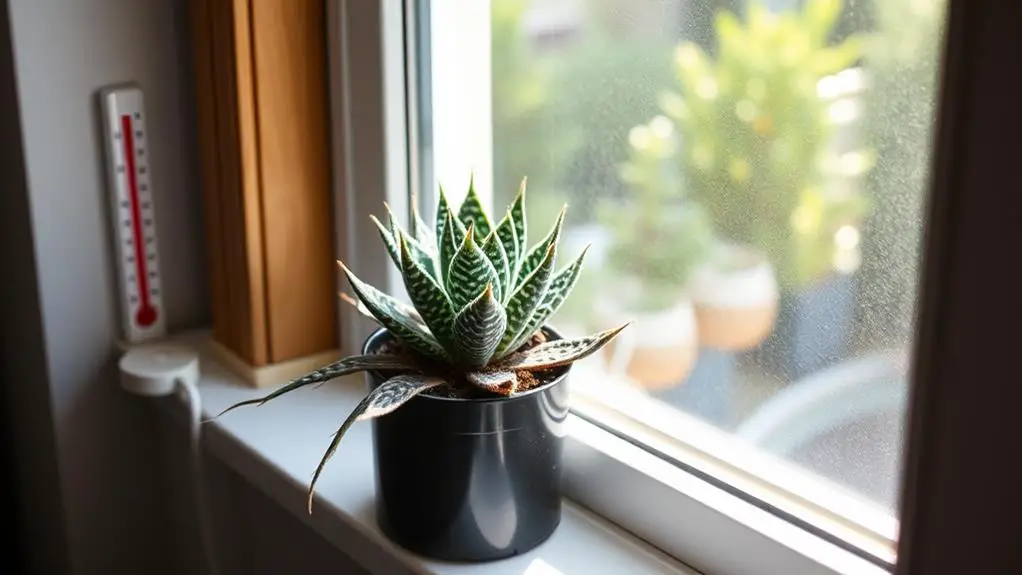
Keeping your Haworthia Zebra thriving hinges on maintaining the right temperature. The ideal temperature range for peak growth is between 15 to 29 degrees Celsius (60 to 85 degrees Fahrenheit). Since this succulent thrives in moderate temperatures, it's perfect for growing indoors where you can easily control the environment.
If you live in non-frosty zones, particularly within USDA hardiness zones 9 to 11, you can also grow it outdoors. However, be aware that Haworthia Zebra isn't cold hardy. If temperatures drop below 0 degrees Celsius (30 degrees Fahrenheit), you'll need to move it inside to protect it from frost.
Temperature fluctuations can affect your plant's watering needs, so consistent monitoring is essential. When temperatures are stable, your Haworthia Zebra will need less frequent watering.
But if the temperature swings a lot, you might need to adjust your watering schedule to keep it healthy.
Propagation Methods
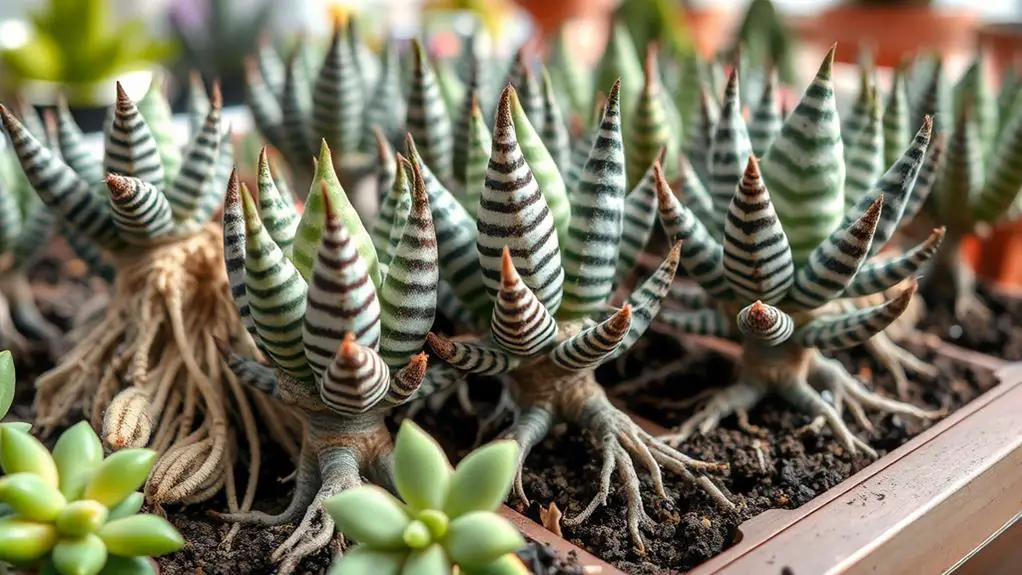
Maintaining the right temperature is vital, but knowing how to propagate your Haworthia Zebra can be equally rewarding. Propagation is a straightforward process that guarantees you can grow more beautiful plants effortlessly. The easiest method is to separate offsets, or baby plants, from the parent plant.
- Separate Offsets: Gently remove the offsets, making sure each one has a few roots to grow successfully.
- Dry Before Potting: Let the offsets dry for 1-2 days before planting. This reduces the risk of rot.
- Use Well-Draining Mix: Replant the offsets in a well-draining cactus mix or blend of pumice, perlite, and sand to guarantee proper drainage and aeration.
After potting, lightly water the new offsets and place them in bright, indirect light. This encourages healthy growth.
Offsets can develop within 3-4 weeks under ideal conditions, making propagation a quick and rewarding process for beginners. Remember, the right mix, light, and watering are vital for successful propagation.
With the proper care, you'll see your new Haworthia Zebra plants thrive in no time, adding a touch of nature to your home. Enjoy the process and the beauty of your growing succulent collection!
Common Issues
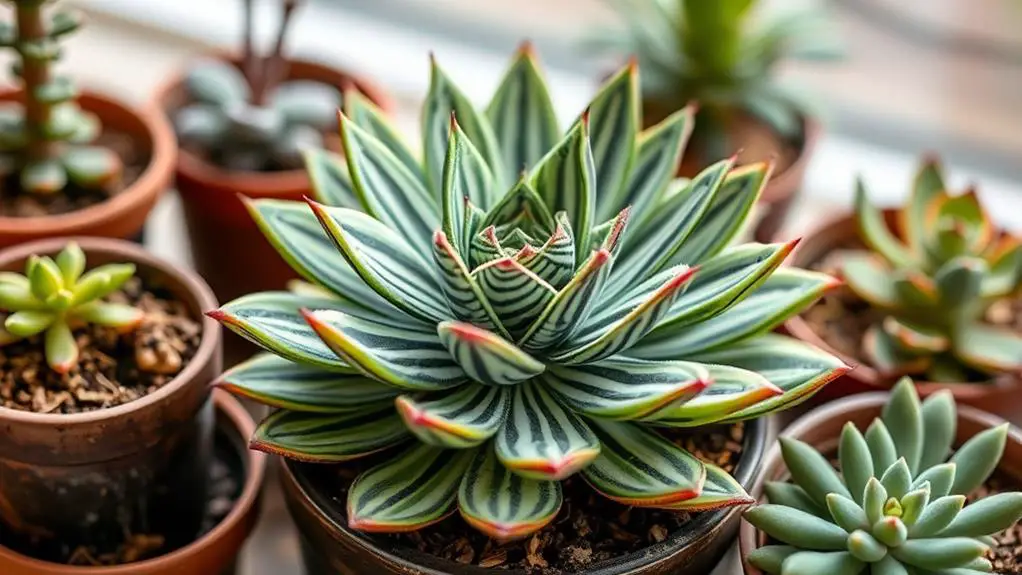
Dealing with common issues in caring for your Haworthia Zebra can be a straightforward process if you know what to look out for.
Overwatering is the most common mistake and can lead to root rot and mushy leaves. To prevent this, let the soil dry out completely before watering again. Make sure you use a well-draining cactus potting mix and that your pots have drainage holes to avoid soggy roots.
If you notice brown leaf tips, it could mean your plant needs more moisture or it's getting too much direct sunlight. Adjusting your watering schedule or moving the plant to a shadier spot can help.
Although generally pest-resistant, Haworthia Zebra can sometimes attract mealybugs. Regularly monitor the plant for signs of these pests, and use insecticidal sprays if needed.
Environmental issues like temperature fluctuations or inadequate light can stress your plant, causing discoloration or wilting.
Keep an eye on the plant's overall condition, and adjust its environment as necessary to keep it healthy.
Pest Management
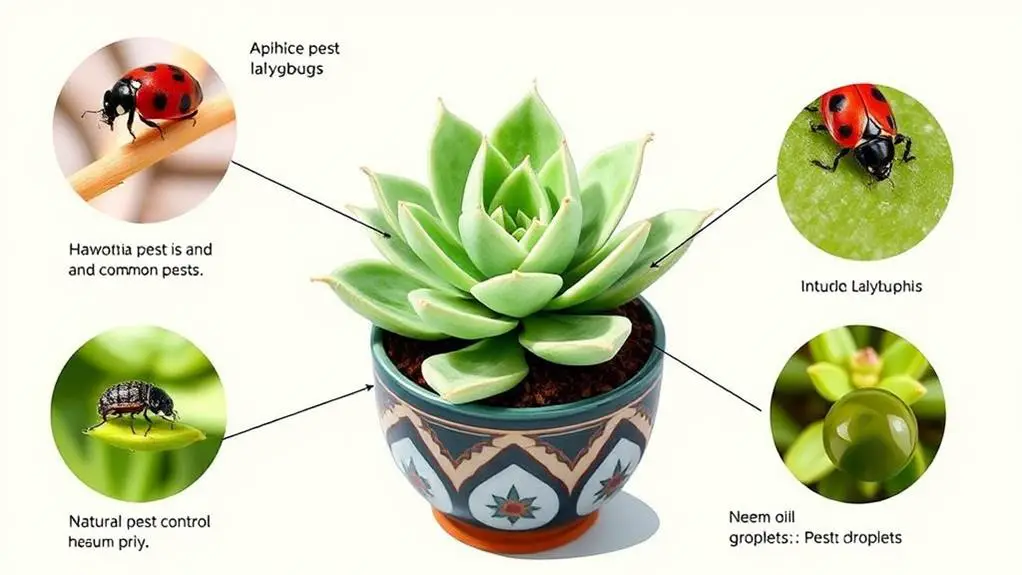
Addressing common issues is essential for the overall health of your Haworthia Zebra, but you also need to manage pests to secure its ideal growth. Even though this succulent is generally pest-resistant, mealybugs can occasionally infest your plant. Regular inspections are key to catching these pests early.
Here's what you can do to keep your Haworthia Zebra healthy and pest-free:
- Manual Removal and Treatments: If you spot mealybugs, remove them with a cotton swab dipped in alcohol. For stubborn infestations, use insecticidal soap to treat your plant.
- Preventive Measures: Avoid overwatering and ensure proper air circulation to discourage pests. Stagnant air and excessive moisture can attract unwanted insects.
- Natural Pesticides: If pests persist, neem oil is a safe, natural option to control various insect populations.
In addition to these steps, regularly cleaning the leaves with a damp cloth helps remove dust and debris, promoting overall plant health and deterring pests.
Frequently Asked Questions
How to Care for a Zebra Haworthia?
To care for a Zebra Haworthia, place it in bright, indirect light, water when soil is dry, and use well-draining soil. Keep temperatures between 60-85°F, avoid frost, and propagate by separating offsets.
What Does a Healthy Zebra Haworthia Look Like?
A healthy Zebra Haworthia has thick, dark green leaves with white tubercles, forming a zebra pattern. The leaves should be firm and plump, growing in a rosette shape without pests or discoloration, thriving in well-draining soil and bright, indirect light.
What Are the Benefits of Haworthia Succulent?
You'll love Haworthia succulents for their low maintenance, ability to thrive in low light, and air-purifying qualities. They're non-toxic to pets and easy to propagate, making them a perfect, safe, and healthy indoor plant choice.
What Are the Best Conditions for Haworthia?
You should place Haworthia Zebra in bright, indirect light, ideally near a south or east-facing window. Keep temperatures between 60-85°F, use well-draining soil, water sparingly, and protect it from extreme conditions like frost and direct sunlight.
Conclusion
By now, you've learned why Haworthia Zebra is perfect for beginner gardeners. It's easy to care for, thrives in various light conditions, and is safe for pets. Just remember to give it bright, indirect light, water it sparingly, and use well-draining soil. Keep an eye on temperature and watch for pests. With a little attention, your Haworthia Zebra will flourish, adding beauty to your home. You've got this—happy gardening!


